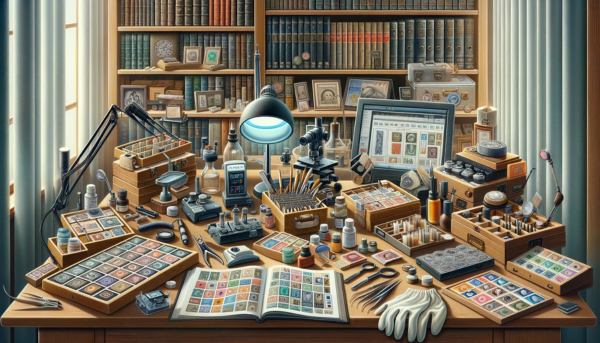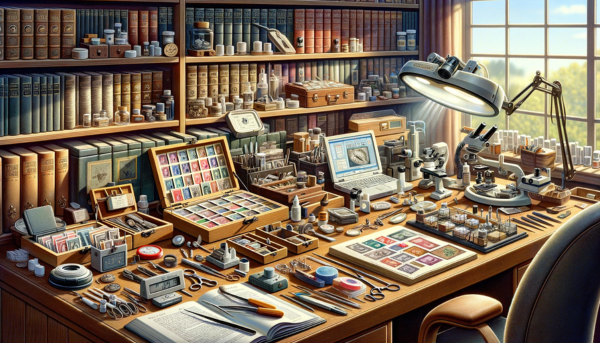
In the fascinating world of philately, the timeless passion for collecting and studying stamps has seamlessly woven through numerous generations, continuously adapting and evolving to embrace both technological advancements and cultural shifts. This enduring hobby, rooted deeply in history and tradition, has seen a remarkable journey from the meticulous organization and preservation of historical stamps to the dynamic and burgeoning field of Crypto Stamps, which represents the intersection of philately with cutting-edge blockchain technology.
Philately, more than just a hobby, is a window into history, culture, and art. Each stamp, a miniature piece of art, tells a story, capturing significant events, personalities, and landmarks, thus offering a unique perspective on the past. Traditional philatelists, with their keen eye for detail and history, have long cherished the process of collecting, examining, and preserving these tiny yet significant tokens of history. They delve into the intricate designs, the subtle variations in printing, and the fascinating errors that sometimes occur, each aspect adding to the richness of their collection.
However, as the world shifts into a more digital era, philately too has seen a significant transformation. The emergence of Crypto Stamps has introduced a new dimension to this age-old hobby, blending the physical aspect of stamp collecting with the digital world of cryptocurrency and blockchain technology. Crypto Stamps represent a novel and exciting frontier for collectors, combining the tactile pleasure of physical stamps with the innovative features of digital ownership and trading. This new era of digital collectibles opens up the hobby to a broader, tech-savvy audience, offering a modern twist to traditional collecting.
Recognizing the diverse needs of both traditional and modern philatelists, this article delves into the essential tools and accessories that enhance the experience of stamp collecting in both realms. For traditional collectors, we explore 25 indispensable accessories that range from the basic necessities for stamp preservation to more advanced tools for detailed examination and analysis. These accessories not only aid in the meticulous care and organization of stamp collections but also enrich the overall experience of delving into the fascinating world of philately.
On the other hand, for enthusiasts of the emerging trend of Crypto Stamps, we identify 8 essential tools and resources. These modern necessities cater to the unique requirements of collecting digital stamps, ensuring secure transactions, reliable storage, and an engaging collection experience in the digital realm. By exploring these essentials, we offer a comprehensive view of how traditional philately intersects with and is enhanced by digital innovation, thus catering to a wide range of collectors from the steadfastly traditional to the digitally inclined.
In summary, this article aims to bridge the gap between the rich, historical practice of traditional philately and the exciting, innovative world of Crypto Stamps. By highlighting the essential tools and accessories for both, we celebrate the evolution of this enduring hobby, ensuring that it continues to captivate and engage collectors of all ages and interests in the modern era.
This article explores 25 indispensable accessories for traditional philatelists and 8 essentials for enthusiasts of Crypto Stamps, offering a comprehensive view of how traditional philately meets digital innovation.

Accessories for Traditional Philately
Before we delve into the specifics of traditional philately accessories, it’s important to appreciate the rich history and enduring charm of stamp collecting. For centuries, philatelists have been captivated by the intricate art and fascinating stories encapsulated in postage stamps. In this section, we will explore the essential tools and accessories that not only enhance the experience of traditional stamp collecting but also ensure the preservation and appreciation of these miniature treasures. From the fundamental stamp albums to the more nuanced tools like perforation gauges and watermark detectors, each accessory plays a crucial role in the life of a traditional philatelist. Whether you’re a seasoned collector or new to the world of philately, understanding and utilizing these tools will deepen your connection to this timeless hobby.
Stamp Albums
The Heart of Philately
Stamp albums are more than just storage; they are the showcase of a philatelist’s journey. Each album tells a story, charting the collector’s progress and interests. The choice of album – whether it’s a classic binder with clear sleeves or a custom-made leather book – reflects the personality and dedication of the collector.
Preservation and Presentation
Acid-free pages are a must in stamp albums. They prevent chemical reactions that can cause discoloration or deterioration of stamps over time. Quality albums also offer varying degrees of protection, from basic coverage to UV-resistant pages that protect against light damage. The layout of the album is important too. Some collectors prefer thematic arrangements, while others follow chronological or geographical orders.
A Lifelong Investment
A good stamp album is a lifelong investment. It’s not uncommon for albums to be passed down through generations, becoming family heirlooms. Therefore, choosing a durable and expandable album is crucial. Look for albums that allow you to add or rearrange pages as your collection grows.
Stamp Tongs
Precision Handling
Stamp tongs differ significantly from ordinary tweezers. They are specifically designed for the gentle handling of stamps. Their smooth, rounded tips prevent tearing or creasing, ensuring the integrity of these delicate paper treasures.
Variety and Choice
Philatelic tongs come in various shapes and sizes, tailored to different handling needs. Some have spade tips for general use, while others have pointed tips for more precise work, like sorting small or intricate stamps. The material of the tongs, often stainless steel or nickel, is also important for preventing rust or corrosion.
An Extension of the Collector
For many philatelists, tongs become an extension of their own hands. They provide a tactile connection to the stamps while protecting them. Mastery of tongs is a skill developed over time, enhancing the overall experience of stamp collecting.
Magnifying Glass or Loupe
A Window to Hidden Details
A magnifying glass reveals a world unseen by the naked eye. It allows collectors to delve into the intricate artistry and craftsmanship of stamps. Details like micro-printing, fine embossing, and subtle color variations come alive under magnification.
Essential for Authentication and Appreciation
For collectors, a loupe or magnifying glass is key in authenticating stamps. It helps in spotting counterfeits, identifying rare varieties, and understanding printing techniques. This tool is not just for verification; it’s also for appreciation, enabling collectors to fully appreciate the art and history embodied in each stamp.
Choosing the Right Magnifier
The choice of magnifier depends on the collector’s needs. Handheld magnifying glasses are popular for their ease of use and portability. Loupes, offering higher magnification, are better suited for detailed examination. Some magnifiers come with built-in lights, enhancing visibility and contrast.
In conclusion, these tools – stamp albums, tongs, and magnifying glasses – are more than mere accessories. They are integral to the philatelic experience, blending functionality with the joy of collecting. They safeguard the past while enhancing the present enjoyment of this enduring hobby.
Stamp Catalogs
Comprehensive Reference for Collectors
Stamp catalogs are much more than just books; they are comprehensive references that offer a wealth of knowledge to collectors. They typically list stamps from all over the world, often categorized by country, year of issue, and thematic subjects. These catalogs not only provide images and descriptions of stamps but also give historical context, explaining the significance of the imagery, the reasons behind certain issuances, and the story of their creation.
A Tool for Valuation and Identification
One of the primary uses of stamp catalogs is in the valuation of stamps. They provide estimated market values based on condition and rarity, which is invaluable for both novice and experienced collectors. This information is crucial for insurance purposes, buying and selling, and for understanding the overall worth of a collection. Moreover, catalogs can help in identifying unknown stamps, offering clues through visuals, postmark styles, and detailed descriptions.
Keeping Up-to-Date with the Philatelic World
Stamp catalogs are regularly updated to reflect new issuances, market changes, and new discoveries in the philatelic world. For collectors, staying up-to-date with the latest editions is essential to keep their knowledge current. Additionally, specialized catalogs focus on particular areas of interest, such as airmail stamps, commemorative issues, or specific historical periods, offering deeper insights for specialized collectors.
Ultraviolet Lamp
Unlocking Hidden Features of Stamps
An ultraviolet (UV) lamp is a vital tool in a philatelist’s toolkit, particularly useful for revealing features that are invisible under normal light. Many modern stamps include security features such as watermarks, special fibers, or phosphorescent markings that can only be seen under UV light. These features are often used to combat counterfeiting and to authenticate stamps.
Enhancing the Experience of Stamp Collecting
Using a UV lamp adds another dimension to the hobby of stamp collecting. It allows collectors to explore the more technical and security aspects of stamps, which is particularly fascinating for those interested in the printing and design process. This tool can also reveal repairs, alterations, and hidden damages, which are critical for accurately assessing a stamp’s condition and authenticity.
A Range of Applications
Beyond stamp collecting, UV lamps have a variety of applications, making them a versatile tool. They can be used for examining currency, legal documents, and even artwork for authenticity. For philatelists who also collect other items, this makes the UV lamp a multi-purpose investment.
Perforation Gauge
Essential for Stamp Identification
The perforation gauge is a simple yet essential tool in philately. Stamps are perforated in various ways throughout history, and these perforations can be crucial in identifying specific issues, variants, or even counterfeits. The gauge allows collectors to measure the number of perforations within a two-centimeter length, a standard method of classification.
Understanding the History and Evolution of Stamps
Perforations in stamps have evolved over time, and understanding these changes can provide insight into the history of stamp production. Early stamps were often imperforate, requiring scissors or tearing for separation. The introduction of perforations was a significant advancement in the ease of use and distribution of stamps. Studying these variations with a perforation gauge can reveal much about the era and technology of stamp production.
Aiding in Accurate Valuation and Trading
For collectors and traders, the exact classification of a stamp can significantly impact its value. A stamp with rare perforation patterns can be more valuable than its common counterparts. Therefore, a perforation gauge is not just a measuring tool; it’s an instrument for ensuring accurate trading and valuation in the philatelic community.
Stamp Cleaning Products
Importance of Proper Cleaning
Stamp cleaning products play a critical role in the maintenance of a philatelic collection. Over time, stamps can accumulate dust, dirt, or even develop mildew, which can significantly affect their appearance and value. Using the right cleaning products is essential to restore and preserve the stamps without causing harm to the delicate paper or ink.
Types of Cleaning Solutions
There are various types of stamp cleaning products available, each designed for specific kinds of dirt or damage. Some are water-based, ideal for gently removing surface dirt, while others might contain mild solvents to address more stubborn stains or residues. It’s important for collectors to understand the nature of the dirt or damage on their stamps to choose the appropriate cleaning solution.
Best Practices for Cleaning Stamps
When cleaning stamps, collectors should exercise caution. The process involves gently applying the cleaning solution with a soft brush or a specialized tool and then carefully drying the stamp to avoid any water damage or warping. It’s always recommended to test the cleaning product on a less valuable stamp to ensure it does not cause any unintended damage.

Cotton Gloves
Protecting Stamps from Natural Oils
Cotton gloves are an indispensable tool for any serious philatelist. The natural oils and sweat from human skin can be surprisingly damaging to stamps. These oils can cause discoloration and deterioration of the paper over time. Cotton gloves provide a barrier, protecting stamps from these harmful effects.
Enhancing the Handling Experience
Using cotton gloves not only protects the stamps but also enhances the handling experience. They provide a better grip, reducing the risk of accidentally dropping or mishandling a stamp. Additionally, wearing gloves signifies a professional approach to stamp collecting, respecting the integrity and value of each piece in the collection.
Maintenance of Cotton Gloves
While cotton gloves are protective, they also need to be kept clean. Dirty gloves can transfer dirt and debris onto the stamps. Regular washing and replacement of gloves are recommended to ensure they remain clean and effective.
Stamp Trays or Boxes
Essential for Organization
Stamp trays and boxes are crucial for organizing stamps, especially during the sorting and cataloging process. They provide a structured way to arrange stamps before they are permanently placed in albums. This organization is key for efficient handling and prevents misplacement or damage to the stamps.
Variety and Customization
These organizational tools come in various sizes and materials. Some trays are designed with compartments or grooves to hold stamps securely, while boxes might have dividers for categorization. Collectors can choose based on the size of their collection and personal preference for organization.
Protecting Stamps During Transport
In addition to organization, stamp trays and boxes are also ideal for safely transporting stamps, particularly when attending philatelic events, exhibitions, or trading sessions. They offer a compact and secure way to carry stamps, ensuring they remain in pristine condition during transit.
Philately Software
Streamlining Collection Management
In the digital age, philately software has become a game-changer for stamp collectors. These programs offer an efficient way to catalog and manage stamp collections, replacing traditional, manual methods. With features like digital catalogs, inventory management, and condition recording, these software programs streamline the entire process of managing a stamp collection.
Enhancing Research and Knowledge
Many philately software programs come equipped with extensive databases and reference materials, making it easier for collectors to research and identify their stamps. They often include images, historical information, and market values, providing collectors with a wealth of knowledge at their fingertips.
Connectivity and Community
Some advanced philately software options offer connectivity to online collector communities and marketplaces, allowing collectors to share their collections, purchase, sell, or trade stamps, and connect with other enthusiasts worldwide. This feature significantly enhances the collecting experience, bringing a global perspective to a traditionally solitary hobby.
Each of these tools and products plays a vital role in the maintenance, organization, and enjoyment of stamp collecting, blending traditional practices with modern conveniences to enrich the philatelic experience.
Microscope or Electronic Loupe
Advanced Detail Examination
Microscopes or electronic loupes are invaluable tools in philately for their ability to reveal the minutest details on stamps. Whether it’s examining the intricacy of a stamp’s design, its printing technique, or even detecting minute flaws and repairs, these devices offer a level of detail far beyond what traditional loupes can provide. This makes them particularly useful for rare or historical stamps, where verifying authenticity and condition is crucial.
Technology Integration
Modern electronic loupes and microscopes often come with integrated technology features such as digital cameras and the ability to connect to computers. This allows for the capture of high-resolution images of stamps, which can be used for digital archiving, detailed study, or sharing with fellow collectors and experts online. Some models even offer specialized software to enhance the stamp viewing experience, such as image analysis tools and digital measuring capabilities.
Educational and Professional Use
For educational purposes, these tools can provide an immersive learning experience, allowing enthusiasts and students to explore the intricate world of philately in detail. In a professional setting, appraisers and expert philatelists rely on these instruments to conduct thorough evaluations and research, ensuring that every aspect of a stamp’s condition and authenticity is accurately assessed.
Precision Scale
Essential for Expert Classification
A precision scale is a must-have tool for philatelists, especially those dealing with rare and valuable stamps. The exact weight of stamp paper and ink can sometimes be a critical factor in identifying different stamp issues, particularly in cases where similar designs were printed in different years or countries. Variations in paper thickness and ink density can be key indicators of a stamp’s origin and authenticity.
Utility in Postal History Research
For those interested in postal history, precision scales can also be used to study the historical aspects of postage, such as rate changes and postal regulations. By weighing old letters and covers, one can gain insights into the postal services of the past, including how postage was calculated and how it influenced mail delivery.
Aiding in Preservation
Understanding the physical properties of stamps can also assist in their preservation. Knowing the exact weight and paper composition can help in determining the appropriate storage and display conditions, ensuring that these delicate items are preserved for future generations.
Stamp Stockbooks
Organizational Efficiency
Stamp stockbooks offer a practical and efficient way to organize a stamp collection. With transparent sheets or strips, they provide a clear view of the stamps, making it easy to organize and display them in a visually appealing manner. This organization is not only important for personal enjoyment but also crucial when it comes to categorizing stamps by theme, country, or era for easy reference.
Protection and Preservation
These stockbooks are designed to protect stamps from common elements that can cause damage, such as dust, moisture, and light. The sheets in these books are typically made from materials that are acid-free and archival-safe, ensuring that the stamps are not exposed to harmful chemicals that could degrade their quality over time.
Ideal for Exhibitions and Sharing
For philatelists who participate in exhibitions or enjoy sharing their collection with others, stamp stockbooks are an excellent tool. They allow for easy transport of collections and provide a professional and attractive way to display stamps. Whether it’s for a local club meeting or a national exhibition, having a well-organized stockbook can make a significant difference in how a collection is perceived and appreciated by others.
Thread Counters
Versatility and Precision
Thread counters, a form of handheld magnifying glass, are not just simple magnifiers. They come with a graduated scale, crucial for philatelists who require precision in their hobby. This tool enables the measurement of the exact dimensions of stamps, which is vital for identifying specific issues and editions. The scale is usually marked in millimeters or another suitable metric, providing accuracy in measurement.
Essential for Detailed Analysis
The fine details of a stamp, such as the intricacy of its design, the quality of its printing, and any minute variations, can be thoroughly examined with a thread counter. This level of detail is often necessary for authenticating stamps or identifying rare errors that can significantly impact a stamp’s value. For instance, slight differences in perforation or design alignment, which are not visible to the naked eye, can be easily detected with this tool.
A Tool for Education and Appreciation
Beyond its practical applications, a thread counter enriches the philatelic experience by offering a closer look at the artistry and craftsmanship of stamp design. It enables collectors to appreciate the subtle nuances that make each stamp unique, turning stamp collecting into not just a hobby, but a journey into a world of miniature art.
Stamp Moisteners
The Need for Gentle Handling
Stamp moisteners are specially designed for the safe handling of stamps, particularly when separating them from envelopes or paper. This process can be delicate, as older stamps are especially prone to damage. Using a moistener ensures that the adhesive on the stamp is softened without excess moisture, which could potentially ruin the stamp.
Different Types for Different Needs
There are various types of stamp moisteners available, ranging from simple sponge-based models to more advanced roller types. Some advanced moisteners even offer a controlled environment to prevent over-wetting, which is essential for maintaining the integrity of the stamp.
A Tool for Preservation
The use of stamp moisteners goes beyond just practicality; it’s about preservation. By preventing tears, creases, or smudges, these devices help maintain the stamp’s condition, which is a key aspect of philately. For collectors, the condition of a stamp is often as important as its rarity, making a stamp moistener an indispensable tool in their arsenal.

Watermark Detectors
Unveiling Hidden Features
Watermark detectors are specifically designed to reveal the hidden watermarks in stamps. These watermarks, often invisible to the naked eye, can be critical for identifying the origin, edition, or authenticity of a stamp. This makes the watermark detector an essential tool for any serious philatelist.
Protecting the Stamp’s Integrity
The primary advantage of using a watermark detector is that it allows for the examination of stamps without direct contact or the use of chemicals, thereby preserving the stamp’s condition. Some detectors use light, while others use safe, specialized fluids that temporarily reveal the watermark without damaging the stamp.
Enhancing Collection Value
Understanding and identifying watermarks can greatly enhance the value of a stamp collection. Watermarks can be the defining feature that differentiates a common stamp from a rare one. The ability to accurately identify these marks can aid collectors in both curating their collections and in assessing the value of potential acquisitions, making the watermark detector a valuable tool in the world of philately.
Transport Cases
Essential for Safe Transit
Transport cases are a vital accessory for any philatelist planning to showcase their collection outside their home. These cases are designed to offer robust protection against physical damage, environmental factors like humidity and sunlight, and even accidental spills during transit. Their utility becomes particularly evident during travel to exhibitions, trade shows, or philatelic meetings.
Customization and Variety
The market offers a wide range of transport cases, varying in size, material, and internal configuration. Some are designed with customizable foam inserts, allowing collectors to create perfectly sized compartments for individual stamps or entire albums. Others feature specialized compartments for additional accessories like magnifying glasses or tongs. The choice of a transport case should be dictated by the size and fragility of the collection, as well as the collector’s personal style and preferences.
Security Features
High-end transport cases often come with enhanced security features like locks or tamper-evident seals, providing peace of mind to collectors when their valuable items are out of sight. Investing in a high-quality transport case is investing in the longevity and preservation of a cherished stamp collection.
Restoration Kit
For the Preservation of Philatelic History
A restoration kit is an advanced tool in the hands of a seasoned philatelist. It contains specialized equipment and materials for repairing damaged stamps, such as thinning paper, tears, or fading. The ability to restore a stamp can significantly enhance its longevity and, in some cases, its value.
Components of a Restoration Kit
Typically, a restoration kit includes solvents, precision tools for handling delicate paper, adhesives that are safe for stamps, and acid-free restoration paper. Some kits might also contain color restoration pens and specialized cleaning solutions. However, it’s crucial to understand that restoration is a delicate process that can potentially decrease the value of a stamp if not done correctly.
The Need for Expertise
Restoration is not recommended for amateur enthusiasts, as it requires a deep understanding of philatelic materials and techniques. Many collectors opt to have their most valuable stamps restored by professionals. However, for those with the requisite knowledge and skills, a restoration kit can be a valuable asset in maintaining the integrity of a rare collection.
Books and Specialized Literature
A Wealth of Philatelic Knowledge
Books and specialized literature are the bedrock of any serious philatelic endeavor. They offer a wealth of information, ranging from the historical context of stamp issues to the technical details of stamp production. This literature can include specialized catalogues, historical overviews, biographies of notable figures in the postal world, and detailed studies of specific stamp issues or eras.
Catalogs and Price Guides
One of the essential components of philatelic literature is the stamp catalog, which provides comprehensive listings of stamps from around the world, complete with images, descriptions, and, often, market values. Price guides are updated regularly, reflecting the ever-changing market dynamics in the world of philately.
Enhancing Collection Strategy
In addition to providing historical and technical knowledge, philatelic literature can also guide collectors in developing a more strategic approach to building their collections. Whether focusing on a particular country, era, or theme, the right literature can provide invaluable insights and guidance.
Philatelic Scissors
Precision in Every Cut
Philatelic scissors are a must-have for any collector who handles stamp sheets or needs to cut mounts and hinges. Unlike regular scissors, philatelic scissors have fine, sharp tips, allowing for precise cuts without damaging the delicate stamps. The precision of these scissors helps in avoiding rough edges that can detract from the stamp’s appearance and value.
Ergonomic Design
Considering that philatelists might spend hours working on their collections, the ergonomic design of these scissors becomes crucial. They are typically lightweight and designed to fit comfortably in the hand, reducing fatigue during prolonged use.
Versatility and Durability
Philatelic scissors are not only used for cutting paper but also for carefully shaping mounts or trimming protective covers. High-quality scissors are made from durable materials like stainless steel, ensuring they remain sharp and functional over many years of use. Their versatility and durability make them an indispensable tool in the philatelist’s toolkit.
Markers for Identifying Reproductions
Importance in Maintaining Collection Integrity
Markers for identifying reproductions are crucial in preserving the authenticity and integrity of a stamp collection. These specialized markers allow collectors to discreetly label stamps that are reproductions, ensuring they are not mistakenly identified or valued as originals. This is particularly important for collectors who deal with a mix of original and replica stamps.
Best Practices for Use
When using these markers, it’s important to apply them in a way that does not damage the stamp or reduce its aesthetic appeal. Many collectors choose to mark the back of the stamp or use a system that is easily recognizable to them but unobtrusive to others. This practice is especially beneficial when showcasing the collection to others or considering a future sale or trade.
Keeping a Record
Maintaining a log or a digital record of which stamps are reproductions and their marked locations can be invaluable. This record-keeping ensures clarity and continuity, especially if the collection is handed down or changes hands.
Repair Detection Fluid
Tool for Authenticity Verification
Repair detection fluid is a specialized tool used by philatelists to identify any repairs or alterations in old stamps. This fluid reacts with different types of glue and paper, revealing patches, restorations, or any changes that have been made to the original stamp.
Application and Safety
The application of this fluid should be done carefully, using a small brush or applicator on a specific area of the stamp. It’s vital to ensure that the fluid is safe for use on stamps, as some fluids can cause damage or discoloration.
Significance in Valuation
Detecting repairs or alterations is crucial in the valuation process of stamps. A stamp’s worth can be significantly affected by its condition. Knowing the true condition helps in accurate valuation, especially for rare or historically significant stamps.
Storage Capsules
Preservation of High-Value Stamps
Storage capsules provide a controlled environment for extremely valuable or rare stamps. These capsules are designed to shield the stamps from environmental factors such as humidity, temperature fluctuations, and UV light, which can cause deterioration over time.
Features and Materials
High-quality storage capsules are usually made of archival materials that do not react with the stamps. Some are equipped with UV-protective glass or plastic and may include humidity control elements to maintain an optimal environment.
Display and Security
Besides protection, these capsules offer an elegant way to display precious stamps without exposing them to direct handling. They often come with secure locks or seals, adding an extra layer of security for the most prized items in a collection.
Stamp Valuation Software
Streamlining the Valuation Process
Stamp valuation software is an innovative tool that helps collectors estimate the current market value of their stamps. By inputting specific details about each stamp, such as its age, condition, rarity, and historical significance, the software can provide a ballpark figure of its worth.
Database and Updates
Most valuation software comes with a comprehensive database of stamps, frequently updated to reflect current market trends and prices. This feature is particularly useful for keeping up with the ever-changing stamp market.
Additional Features
Many stamp valuation programs also offer additional features like collection management, where collectors can keep track of their inventory, trade duplicates, and plan future acquisitions. Integration with online auction sites and dealer networks can also provide real-time market insights.
By expanding on these topics, the content delves deeper into each accessory, providing valuable information that enhances the quality and depth of the article, ensuring it’s comprehensive and informative for the reader.

Accessories for «Crypto Philately»
Cryptocurrency Wallets
Cryptocurrency wallets are essential in the world of Crypto Philately, serving as a critical interface for managing and safeguarding blockchain-linked assets. These wallets are more than just digital storage spaces; they are the cornerstone of a crypto philatelist’s collection, offering both accessibility and security for digital assets tied to Crypto Stamps. Hot wallets, connected to the internet, offer ease of access and efficient management, making them ideal for active trading and regular transactions. In contrast, cold wallets provide robust offline storage, significantly reducing the risk of cyber-attacks and unauthorized access.
The selection of a wallet is a balancing act between the need for immediate access and the demand for stringent security. For the crypto philatelist, understanding the intricacies of wallet security, including the role of private and public keys, as well as the mechanisms behind blockchain transactions, is essential. This knowledge not only safeguards the collection but also enhances the overall experience of collecting Crypto Stamps. Furthermore, as the crypto landscape evolves, staying informed about the latest developments in wallet technology is vital for maintaining the security and integrity of one’s collection.
Blockchain Software or Apps
Blockchain software and applications are pivotal for anyone involved in Crypto Philately. These platforms provide an intuitive interface for interacting with the blockchain, where each Crypto Stamp is more than just a collectible item—it’s a unique digital token. Through these applications, collectors gain the ability to verify the authenticity, trace the ownership history, and understand the rarity of each Crypto Stamp. Moreover, these tools enable the seamless execution of transactions, be it buying, selling, or trading, in the digital marketplace.
For the modern philatelist, these blockchain applications are not just tools but gateways to a global community of collectors and enthusiasts. Keeping abreast of the latest software and apps is not only about accessing new features; it’s about staying connected to the evolving landscape of digital stamp collecting. These applications often include community forums, trading platforms, and educational resources, making them an indispensable part of the Crypto Philately experience.
Cybersecurity Protection
In the realm of Crypto Philately, where digital assets can carry significant value, cybersecurity is not just an option; it’s a necessity. Protecting these assets from the myriad of cyber threats, such as hacking, phishing, and other malicious activities, requires a proactive and vigilant approach. Strong, unique passwords for wallets and blockchain applications are the first line of defense. Coupled with this, the implementation of two-factor authentication (2FA) adds an additional layer of security, significantly reducing the risk of unauthorized access.
Awareness and education about common cybersecurity threats in the cryptocurrency domain are crucial. This knowledge enables collectors to recognize and avoid potential scams and threats. Regular updates of wallet software and the use of reputable cybersecurity solutions further fortify the defenses of a digital philatelic collection. In essence, effective cybersecurity practices are not just about protecting assets; they’re about ensuring peace of mind for the collector.
High-Resolution Scanners
For the crypto philatelist, high-resolution scanners are more than just a tool; they are a bridge connecting the tangible world of traditional stamps with their digital counterparts. These scanners capture every intricate detail and hue of a stamp, creating a digital replica that is true to the original. This high-fidelity digitization is crucial, not just for archival purposes but also for verification and trading in the digital realm.
For Crypto Stamps, which often have a tangible element, high-resolution scans ensure that their digital representation is as authentic as possible. This is especially important when these stamps are displayed in digital galleries or used for online trading and verification. The scans also allow for the creation of a digital archive, providing a backup for rare or valuable physical stamps and enabling collectors to share their collections with a global audience. In the world of Crypto Philately, where the physical and digital converge, high-resolution scanners play a pivotal role in preserving the legacy and enhancing the experience of stamp collecting.

Secure and Stable Internet Connection
The Backbone of Digital Philately
A secure and stable internet connection is not just a convenience but a necessity in the realm of digital philately, particularly for those dealing with Crypto Stamps. The blockchain technology that underpins these digital assets requires a continuous, reliable online connection to access and manage them.
Safeguarding Digital Assets
A robust internet connection ensures that transactions are processed smoothly and without interruption. This is crucial for real-time updates and for maintaining the integrity of digital wallets and blockchain transactions. An unstable connection could lead to failed transactions or even loss of data, which is particularly risky when dealing with valuable digital assets like Crypto Stamps.
Enhancing User Experience
Moreover, a stable connection improves the overall user experience. Whether it’s browsing online catalogs, participating in digital auctions, or simply managing one’s collection, a fast and reliable internet connection enhances the efficiency and pleasure of these activities, making the hobby more enjoyable and less frustrating.
Education and Resources on Blockchain and Cryptocurrencies
Navigating the Digital Landscape
Understanding blockchain technology and cryptocurrencies is paramount for crypto philatelists. As this is a relatively new and rapidly evolving field, continuous education and access to reliable resources are crucial. This knowledge not only aids in making informed decisions but also in appreciating the full value and potential of Crypto Stamps.
Resources for Learning
There are various resources available for learning, including online courses, webinars, forums, and blogs dedicated to blockchain and cryptocurrency. Leveraging these resources can provide deeper insights into how blockchain works, its impact on the philatelic world, and the future possibilities it holds.
Staying Updated
The blockchain and cryptocurrency sectors are known for their fast-paced evolution. Staying updated with the latest developments, trends, and best practices is vital. This ongoing education can help collectors and enthusiasts stay ahead of the curve, ensuring they can make the most of their digital philatelic endeavors.
High-Quality Printer
Bringing Digital to Physical
For Crypto Stamp collectors who wish to have a physical representation of their digital assets, a high-quality printer is indispensable. It allows for the creation of tangible copies of Crypto Stamps, which can be added to traditional collections or displayed.
Quality and Fidelity
The printer should be capable of producing high-resolution prints to capture the intricate details of stamp designs. This ensures that the physical copies are not only visually appealing but also accurate representations of their digital counterparts.
Versatility and Functionality
Ideally, the printer should be versatile enough to handle different types of printing paper and sizes, offering collectors the flexibility to customize their prints. Features like color fidelity and longevity of prints are also important considerations, ensuring that the printed stamps remain vibrant and durable over time.
Physical Storage Devices for Cryptocurrencies (Cold Wallets)
Enhanced Security for Digital Assets
Cold wallets provide a high level of security for storing cryptocurrencies associated with Crypto Stamps. Unlike hot wallets, which are connected to the internet and more vulnerable to cyber threats, cold wallets store digital assets offline, significantly reducing the risk of hacking and theft.
Types of Cold Wallets
There are various types of cold wallets, including hardware wallets (like USB devices) and paper wallets. Each type offers its own balance of security and convenience. Hardware wallets are generally considered more user-friendly, while paper wallets are seen as a more rudimentary, yet highly secure, option.
INTRODUCING THE WORLD’S MOST SECURE COLD WALLET
Long-Term Protection and Peace of Mind
For crypto philatelists, using a cold wallet means added peace of mind, especially when dealing with a significant investment in digital stamps. These storage devices ensure that digital assets remain safe, even in the face of potential online vulnerabilities, making them an essential tool for anyone serious about collecting and investing in Crypto Stamps.

Conclusion
Philately, often regarded as the «king of hobbies,» has indeed journeyed far beyond its initial conception. From the days of carefully curated stamp collections in ornate albums to the latest innovations in blockchain technology, this hobby has continuously adapted and evolved. The world of philately not only represents a fascinating intersection of history, art, and now, cutting-edge technology, but it also offers a unique window into the changing ways we perceive and value these miniature pieces of paper.
The traditional philatelist, armed with magnifying glasses, tweezers, and meticulously organized albums, finds joy in the tangible. Each stamp, with its intricate design and historical significance, tells a story. These stories are not just about the stamps themselves but about the eras, events, and personalities they represent. The physical act of arranging and rearranging stamps in albums, the feel of the paper, the careful inspection of a watermark – all these elements create an experience steeped in tradition and nostalgia.
On the other hand, the emergence of Crypto Stamps has introduced a new dimension to this venerable hobby. It bridges the gap between the traditional and the modern, appealing to a generation that is more in tune with digital technology and cryptocurrencies. The concept of owning a digital asset, secured by blockchain technology, has added a novel layer of intrigue and value to stamp collecting. This digital transformation is not just about the shift from physical to digital, but it’s also about redefining what it means to collect, own, and trade stamps.
Furthermore, the variety of accessories available for both traditional and Crypto Philately demonstrates the hobby’s adaptability and its enthusiasts’ willingness to embrace change. The classic tools like albums and tongs are not just tools; they are a tribute to the hobby’s rich history. In contrast, digital wallets and blockchain software represent the new frontier, opening up possibilities for secure trading and global connectivity among collectors.
In essence, philately’s embrace of blockchain and digital technologies does not diminish its historical and artistic roots; instead, it enhances the hobby’s appeal, making it relevant in a digital age. It underscores the versatility and enduring charm of stamp collecting, showing how a hobby born in the 19th century can remain vibrant and engaging in the 21st century.
As philately continues to evolve, it will undoubtedly adopt more innovative tools and technologies, each adding a new chapter to its already rich history. Whether one prefers the tactile pleasure of handling vintage stamps or the excitement of trading Crypto Stamps, the world of philately offers something for everyone. It stands as a testament to the enduring allure of collecting, a pursuit that transcends time and technology, connecting people to history, art, and the ever-evolving world around them.





